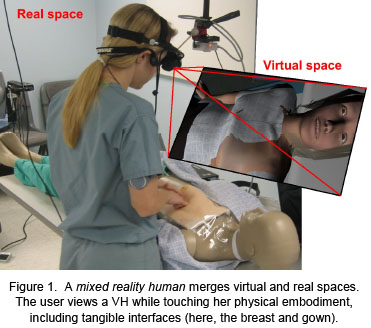From Monday 10th to Wednesday 12th March 2008 was the actual IEEE VR conference. See the complete program.

svgallery=ieee_vr_2008
Training
Again, for me one of the most interesting applications of AR/VR is training. See also Virtual Humans below.
In the paper by John Quarles, Samsun Lampotang, Ira Fischler, Paul Fishwick and Benjamin Lok, from University of Florida, “Mixed Reality Merges Abstract and Concrete Knowledge” we have seen that Augmented Reality helps .. merge abstract and concrete world. That means that it’s perfect for training on real and complex machines by adding abstract information that helps understand the underlying mechanics. When the user operates the physical machine, the virtual model is also updated, an you can see the updated augmented information to understand the results of your actions.
Virtual Humans
I really enjoyed the Virtual Humans sessions, and particularly the “Virtual Human + Tangible Interface = Mixed Reality Human” paper by Aaron Kotranza and Benjamin Lok from University of Florida. Here’s the abstract of the paper :

Virtual human (VH) experiences are receiving increased attention for training real-world interpersonal scenarios. Communication in interpersonal scenarios consists of not onlyspeech and gestures, but also relies heavily on haptic interaction –interpersonal touch. By adding haptic interaction to VH experiences, the bandwidth of human-VH communication can be increased to approach that of human-human communication.
To afford haptic interaction, a new species of embodied agent isproposed – mixed reality humans (MRHs). A MRH is a virtual human embodied by a tangible interface that shares the same registered space. The tangible interface affords the haptic interaction that is critical to effective simulation of interpersonal scenarios. We applied MRHs to simulate a virtual patient requiring a breast cancer screening (medical interview and physical exam). The design of the MRH patient is presented. This paper also presents the results of a pilot study in which eight (n = 8) physician-assistant students performed a clinical breast exam on the MRH patient. Results show that when afforded haptic interaction with a MRH patient, users demonstrated interpersonal touch and social engagement similarly to interacting with a human patient.
What this all means is that interaction with virtual humans help change real life behavior in the real world. Self perception is changed. ixed reality humans, by adding the dimension of touch give the trainee more empathy, social engagement, through interpersonnal touch. Touch drives the interaction. Users interacted with the MVH as if they were real humans, so what they learn in this training is directly transferable to the real world.
Honors
As for the honors, Bernd Fröhlich got the VR Technical Achievement Award, and Bowen Loftin got the VR Career Award.


